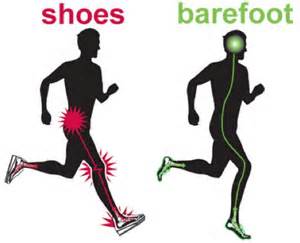In 1968 Nike invented the modern running shoe – Nike Cortez. One of the founders of Nike, Bill Bowerman, stuck a large lump of rubber under the heel of the shoe to, as he said, to stop the feet tiring and give them an edge. With the heel raised, he reasoned, gravity would push them forward ahead of the next man. Before this runners like famous Roger Bannister all ran with backs straight, knees bent and feet touching the ground right under their hips, using their toes as a balance. Their only shock absorption came from the compression of their legs and their thick pad of midfoot fat. Thumping down on their heels was not an option.
In addition to Bowerman’s experiments finding the new modern running shoe, he wrote articles and books about a new running style; and it was the ignition of the Jogging Wave .
The rest is history. Today Nike’s turnover is around $25 Billions. The running shoe industry alone revenues over $20 Billions yearly.
But is this industry one of the largest fake in modern times?
According to the book Born To Run by Christopher McDougall it may be. McDougall uncovers a frightening truth: since the introduction of the Cortez shoe the injuries from running have exploded. Leading experts agree it depends on the fact that the modern athletic shoes package the feet so much that they become too weak. The muscles in the feet prevents to be strong, the more they get packaged.
And despite some thirty years, all multi-national brands of running shoe makers and their marketing suggestions, no manufacturer has ever invented a shoe that is any help at all in injury prevention. The more expensive, the more injuries.
Some years ago two Nike managers were watching one of the top athletics teams they were sponsoring. They were confused since the athletes seemed to prefer – to run barefoot. “Haven’t we sent enough shoes”, the Nike folks asked. The athletes told they could train a lot more without getting injuried when running barefoot.
If we translate this story to sales strategy and process, it hits me that it’s very near the same. We invest millions of dollars buildning support systems, analytical models, big data, strictly KPI:s to follow, expensive CRM-systems…but do we really solve the real problems? Are we really making more deals? Do we really land higher sales revenues? Do we really find the most profitable opportunities?
My conviction is that we package our sales organization so hard, like machines, that we lose our creativity. We don’t let our feet – sorry: our sales reps – look for the best opportunities, because we tie them up to follow our one-size-fits-all sales process, supported by strictly and detailed KPI:s. The result is that everybody are looking for the same type of deals – even if the market and competition changes very rapidly.
Why not going for a barefoot sales process?
Your reps are thinking people, experienced enough to radar where to search, using the best method, building the most fruitful relationships. You will definitely get a flexibility to meet changes, meet competition; it’s an agile sales process. What you need is a support for Catching Point. That means, it’s rather the beginning that is important, than the process itself. The focus task, with this perspective, for a creative sales rep is to recognize and catch needs, as clever as possible and based on his experience of the industry or as a business man. The only support they need at this point is a sort of easy-to-use app to register what the need is, to whom and when it’s time to take the next contact. Nothing more. When times comes, the rep heavily spend their time to detail the potential customer’s need and the solution to it, but not until then. It’s a Lean Sales Process – or what I call a Barefoot Sales Process.
And like in barefoot running; set your sales reps free and you would obtain a lot more creativity finding revenues and profits. Let them BE true sales reps, not prisoners in stiff shoes – or processes, KPI:s and organizations!
Checkout the Sales Scenario app for iPad, thanks.
Good luck and Best Regards,
Stefan


2 Replies to “Barefoot Sales Process”